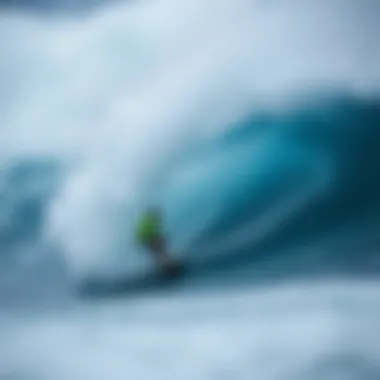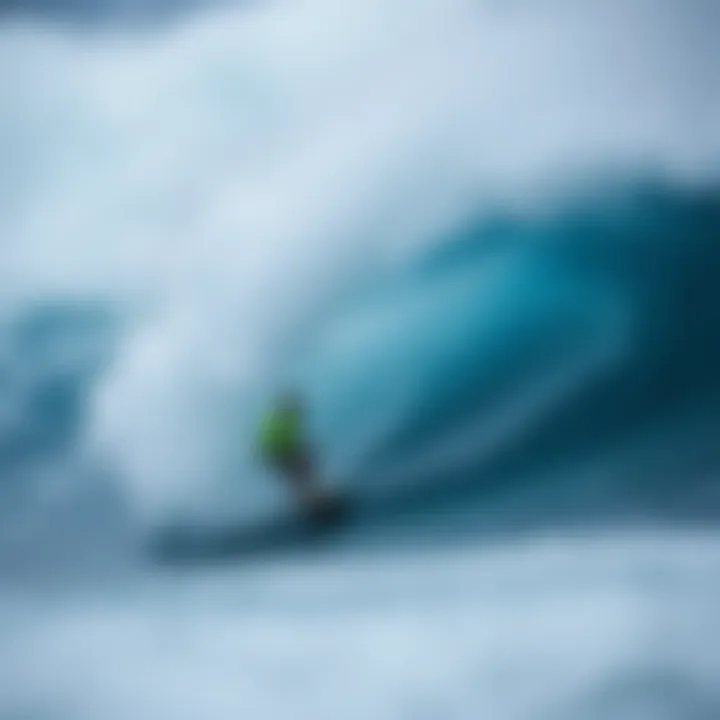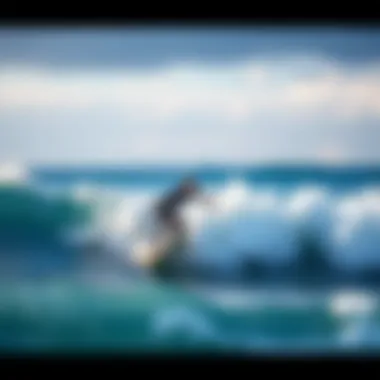Understanding Wind Speed Effects on Surfboarding in the USA


Intro
Surfing is not just about catching the perfect wave; it’s a dance between the ocean, the board, and the wind. For surfboarding enthusiasts, understanding wind speed and direction can drastically impact surf conditions and techniques. This exploration digs deep into the current wind speed map of the USA, shedding light on how these elements affect surfboarding across various regions.
Wind plays a crucial role in determining wave quality. Strong winds can create choppy waters, while lighter breezes may lead to smoother surfaces that are ideal for riding. Knowing these conditions can help both novices and seasoned surfers strategize their outings.
In the sections that follow, we will examine how surfboard technology and surfing techniques intertwine with wind conditions to enhance the surfing experience. Through this comprehensive guide, we hope to equip surfers with the knowledge they need to make the most of their time in the water.
Understanding Wind Speed and Its Importance
Wind speed is not just a numerical value tossed around by meteorologists; it serves as a crucial element that shapes various outdoor activities, particularly surfing. The winds that sweep across the United States can either create exhilarating surf conditions or render them damn near impossible to ride. For surfers, understanding these variations is paramount. Knowing wind speeds means knowing when to grab the board and hit the waves or when it might be better to stay dry.
Surfers have to factor in both the strength and direction of the wind when planning their sessions. A brisk offshore wind might clear the way for pristine waves, while an onshore wind can create chop and make for less favorable conditions. By delving into wind speed data, surfers can drastically improve their chances of catching those perfect swells.
A point worth considering is that not all surfers are the same. Beginner surfers may prefer milder conditions, while seasoned riders thrive on more challenging waves. Hence, having accurate and current wind speed information can be a game-changer, regardless of skill level. For surfboard enthusiasts, this knowledge isn’t merely beneficial; it's key to elevating their overall surfing experience.
Key benefits of understanding wind speed for surfers include:
- Enhanced Decision Making: Whether it's a bright sunny day or storm clouds gathering, wind conditions dictate what's rideable.
- Increased Safety: Strong winds can lead to rough waters and unsafe conditions. Knowing when safety is at risk can prevent accidents.
- Skill Development: By understanding how different wind conditions affect waves, surfers can adapt their techniques effectively.
Ultimately, having a firm grasp of wind speed allows surfers to take advantage of nature’s gifts while protecting themselves from potential hazards. Ignoring this aspect of surfing is like sailing a ship without a compass—you're bound to end up lost or worse.
Defining Wind Speed
Wind speed, simply put, is the measurement of how fast air is moving in a given direction. It's typically measured in kilometers per hour (km/h) or miles per hour (mph). Various instruments, such as anemometers, are used to capture these speeds, providing crucial data for weather forecasts and recreational planning alike.
Wind speed can fluctuate significantly based on geographical location, time of day, and even the season. For surfers, these variations can determine the quality and nature of the surfing experience.
Forms of Measurement:
- Gusts: Brief bursts of high wind speed that can significantly impact surfing conditions.
- Sustained Wind Speed: The average wind speed over a particular time frame, usually a 10-minute interval.
The interplay of these measurements can transform a day at the beach from a sweltering sunbath to a rolling adventure through formidable swells.
The Role of Wind in Surfing
Wind plays a pivotal role in determining not only the surf conditions but also the overall experience of surfers. It influences how waves form and break, often making or breaking surfing sessions.
Types of Winds and Their Impact:
- Onshore Winds: These winds blow from the ocean towards the land. Often, they create choppy, messy surf, making it difficult to catch clean waves.
- Offshore Winds: When the wind blows from the land out to the sea, it helps to create cleaner and more well-formed waves, ideal for surfing.
"A good wind can turn a flat day into a thrilling ride; knowing how to read these signs can set surfers on the path to unforgettable experiences."
So, for those eager to experiment with different surf techniques or challenge themselves on bigger waves, understanding wind dynamics is essential. Ignoring this can lead to missed opportunities or, worse, precarious situations amidst the ever-changing sea. In light of these facts, it becomes clear that mastering the knowledge of wind speed will offer surfers an edge in both skill and enjoyment.
Current Wind Speed Mapping Techniques
Wind speed mapping techniques play a crucial role in understanding wind patterns across the United States. For surfers, this knowledge is not just a luxury; it’s essential for optimizing surf conditions. Recognizing the nuances in wind speed can mean the difference between a mediocre day on the waves and an exhilarating surf session. Let’s delve into how these mapping techniques work and what they can potentially do for surfboard enthusiasts.


Data Collection Methods
Collecting accurate wind speed data is no small feat. Various methods serve this purpose, ensuring that surfers have access to real-time, reliable information.
One of the most popular methods includes the use of anemometers—devices that measure wind speed. These are often installed at weather stations dotted around coastal areas, providing critical data. However, it’s also essential to have consistent coverage. Thus, satellite observations have become invaluable. By analyzing atmospheric conditions from space, satellites can offer broader insights into wind patterns that ground-based anemometers might miss.
In addition, buoys placed in the water collect wind and wave data, acting as front-row seats to the action. As these buoys float, they transmit real-time information back to databases, allowing surfers to check conditions prior to heading out. The combination of these methods ensures a comprehensive understanding of wind dynamics, critical for those relying on nature's whims.
Technological Advancements in Wind Mapping
The world of meteorology has seen immense technological strides in recent years. Doppler radar systems, for instance, have joined the toolkit of wind mapping, providing not only speed but also direction. This is a game changer for surfers. Instead of merely knowing how fast it's blowing, surfers can gauge where the wind is coming from, which directly impacts wave behavior.
Additionally, advancements in mobile applications allow for immediate access to wind maps. Surfers can check their favorite spots from their phones, receiving live updates from various sources. Some apps even feature augmented reality interfaces, placing wind data right on the surf spot itself, bridging the gap between data and practical application. With such technology, surfers can make decisions that enhance their experience, ensuring they're riding the waves at optimal times.
Integrating Meteorological Data
To grasp the wind’s influence on surf conditions fully, integrating various meteorological data becomes essential. Wind speed doesn't exist in a vacuum; it's one piece of a larger puzzle that includes humidity, temperature, and even tidal patterns.
Meteorological models now combine these factors, creating a comprehensive picture of what surfers can expect. For example, a spike in wind speed might indicate evolving weather patterns that could, in turn, enhance or degrade wave quality. Moreover, by studying historical trends in wind speed and its connection to weather events, surfers can learn patterns over time and prepare for optimal surfing conditions.
With platforms like NOAA and National Weather Service offering extensive resources and data, surfers can benefit greatly by tapping into these tools. It’s about making informed choices; understanding the interplay of all these elements can lead to better surfing days.
"Wind speed mapping techniques provide surfers with the insights needed to maximize their time on the water, translating data into better experience."
Analyzing the Current Wind Speed Map of the USA
Understanding the wind speed map of the USA is paramount for surf enthusiasts. Wind, in its essence, is not just a nagging weather detail; it shapes the very arteries of our surf breaks. Analyzing wind patterns and speeds can provide surfers with insights into the conditions they might face at their favorite beaches, significantly affecting wave quality and safety.
When surfers attune their practice to the wind speed map, they open doors to enhanced experiences. Taking the time to study these aspects means knowing how to ride the wave just right or knowing when it's better to hang up the wetsuit. With a vast coastline and a plethora of surf spots, each area exhibits unique wind behaviors, impacting everything from swell angles to wave size.
Regional Wind Patterns
Wind patterns across the US present a colorful tapestry influenced by geography, time of year, and atmospheric conditions. For example, coastal regions like California experience a consistent trade wind pattern, promoting ideal surf conditions during the summer months. Surfers looking to catch those perfect summer swells benefit immensely from this regularity.
On the other hand, the East Coast experiences varying wind conditions influenced by the Atlantic. North winds can create clean, organized swell, making it a prime target for surfing during fall and spring. Understanding these regional dynamics enhances a surfer's ability to forecast conditions and plan their sessions accordingly. This kind of knowledge pays off, whether you're a seasoned pro or a weekend warrior.
Peak Wind Speed Areas
Not all surfing spots are equal, especially when we examine wind speed. Certain regions, like the Outer Banks of North Carolina, are notorious for their gusty winds, which can turn a pleasant day into a challenging one quickly. Winds can whip up massive waves that thrill experienced surfers keen on exhilarating rides but might deter novice surfers.
Regions such as Hawaii and Southern California also showcase prime wind behavior. During winter months, hurricanes and storms can lead to exceptional peak wind speeds, creating larger surf. Surfers need to be well-informed about these hotspots to not only choose when to ride but also to comprehend the inherent risks involved.
Trends in Wind Speed Variability
The wind speed map of the USA is ever-evolving, influenced by natural phenomena, including climate change and seasonal shifts. Recent studies have indicated an increase in wind speed variability, particularly in certain regions. Such fluctuations can affect not only surf conditions but also the patterns of local weather systems, leading to conditions that might catch surfers off guard.
For instance, unexpected wind speeds can generate chaotic waves, requiring surfers to adapt swiftly. Moreover, understanding these trends allows surfers to take advantage of unexpected opportunities, whether it’s a quick session during an oddly windy afternoon or making longer-term plans based on seasonal shifts.
In summary, analyzing the wind speed map is not merely another chore for surfers; it can be the difference between a flawless session and a day spent home, sprawled on the couch. The insights drawn from wind behavior enable surfers to navigate both the waves and wind with enhanced awareness, adding a layer of safety and enjoyment to their surfing adventures.


The Impact of Wind Speed on Surf Conditions
When surfers hit the waves, they often rely on more than just their skills; wind speed plays a significant role in shaping the surf experience. Understanding how wind interacts with ocean water is crucial for both safety and enjoyment. This section delves into the ways wind speed influences surf conditions, laying out the impacts in terms of wave formation, quality of surf, and overall safety considerations.
Influence on Wave Formation
Wind speed is a critical factor in the creation of waves. As wind moves across the water, it transfers energy to the ocean's surface, crafting waves of various sizes and strengths. In general, stronger winds can generate larger waves, or at least waves with more powerful breaking forces. But not all wind is equal. A brisk wind can be beneficial, while fierce gusts may lead to choppy, uncomfortable surf.
It's important for surfers to gauge not just how strong the wind is, but also its consistency. Waves that are generated under steady wind conditions are often more uniform and easier to ride, whereas erratic gusts can throw surprises, leading to unstable surfaces that might not be as safe:
- Ideal conditions for surfers often include wind speeds between 10 to 20 knots.
- High winds above 30 knots can create chaotic surf, reducing overall rideability.
So the next time you survey the wind speed, remember—it’s not just a number. It’s a direct reflection of how the ocean will treat you.
Wind Direction and Surf Quality
Another layer to the wind's influence is its direction. The way wind blows across the water can enhance or diminish surf quality. For instance, offshore winds, those that blow from land to sea, can provide clean, glassy waves—emphasizing the beauty of a smooth surf session. In contrast, onshore winds can create waves that lack form and stability, leading to frustrating conditions.
Here’s how wind direction can affect surf quality:
- Onshore Winds: Can produce messy waves, making it difficult to maintain balance. Surfers may find themselves battling the chop rather than riding the wave.
- Offshore Winds: Generally offer the best surfing conditions. With cleaner waves, surfers can plan their maneuvers with more ease and style.
- Cross-Shore Winds: These can lead to inconsistent wave forms, offering mixed conditions that might challenge even experienced surfers.
For best results, knowing the wind direction alongside its speed can help surfers to time their outings perfectly.
Safety Considerations for Surfers
Wind speed does not merely influence the joy of riding waves; it also carries important safety implications. High winds can lead to hazardous conditions both on the water and on the shore. When wind speeds soar above certain levels, surfers should approach with caution or postpone the surf altogether.
Some key points regarding safety:
- Waves Produced by High Winds: These can be more powerful and difficult to navigate, increasing the risk of wipeouts.
- Tidal Changes Influenced by Wind: Strong winds can push water in ways that impact currents, potentially leading to rip tides or swift currents.
- Gear Check: High winds can affect equipment; ensure gear is well maintained to handle more turbulent conditions.
The wind is a wild companion—understanding its moods can mean the difference between an exhilarating ride and a challenging day out on the ocean.
In summary, the impact of wind speed on surf conditions serves as an essential factor in a surfer's decision-making process. It is vital to consider how both speed and direction affect the surf, aiding enthusiasts in making informed choices for their next adventure on the waves.
Utilizing Wind Data for Better Surfing Experience
Understanding wind data can be pivotal for surfers looking to enhance their time on the water. Having a clear idea of wind patterns and their implications can mean the difference between a mediocre session and an exhilarating ride. Surfers who learn to harness this information can not just decide when to hit the waves but also adapt their techniques to suit ongoing conditions.
Choosing the Right Times to Surf
Timing is everything when it comes to surfing, and wind speed plays a significant role in this equation. Surfers need to observe how different wind conditions affect ocean swells. Generally speaking, lighter winds are favorable for catching clean waves, while strong winds can deteriorate surf quality.
Wind patterns often vary throughout the day, influenced by weather phenomena such as sea breezes or local topography. For instance, mornings and late afternoons are often ideal since the wind is usually calmer at these times. When the wind is gentle, it allows for better wave shapes, ensuring that surfers can ride smoother and more fun waves.
"The calm before the storm can be the calm before the wave."
Using wind data and local wind maps, surfers can pinpoint the best time to surf for their favored spots. For example, Surfline and Windy.com provide daily updates on wind conditions and forecasts, helping surfers make informed decisions.
Adapting Techniques Based on Wind Conditions


When owners are out there, adapting your surfing technique to suit the wind can elevate your performance. When faced with challenging wind conditions such as onshore winds, surfers should focus on maintaining balance and control, as these winds can disrupt the flow.
For offshore winds, however, the ride can be magical. These winds help in forming clean, peaky waves, giving surfers the chance to execute tricks with greater ease. Understanding how to adjust stance and maneuver accordingly becomes crucial in these conditions.
Here are some tips to consider based on different wind conditions:
- Onshore Winds: Keep your weight centered and stay stable. Avoid overly aggressive turns as the wave may break unpredictably.
- Offshore Winds: Use this to your advantage; practice high-performance maneuvers and be confident in your turns since the waves won’t collapse as quickly.
Future of Wind Speed Mapping and Surfing
Understanding where wind speed mapping is headed is crucial for surfers. As enthusiasts of the ocean, having precise insights on wind patterns translates directly into better experiences on the waves. Innovations in this field not only enhance the accuracy of data but also increase accessibility for all surfers—whether they ride the waves daily or indulge in the thrill on vacations.
Innovations in Wind Observation
The technological landscape is always shifting, and wind observation tools are getting a fresh makeover. Drone technology, for instance, is lifting off, offering live data capture from hard-to-reach beach areas. Drones can easily hover above surf breaks, collecting real-time wind readings and providing surfers with crucial information just moments before they head into the water.
Moreover, satellite imagery is becoming more sophisticated. Companies are now able to monitor large swathes of ocean with remarkable detail. These satellites can track not just wind speed but also other factors like wave height and surface currents, presenting a holistic view of surf conditions.
In addition to technology, there are apps emerging that aggregate data from different sources, offering a comprehensive wind speed analysis. These applications often compile user-generated reports from surfers who are currently out on the water. The combination of verified data with real-world experiences enhances the accuracy of wind forecasts, allowing surfers to plan their outings with clear expectations.
Data Accessibility and Surf Decision-Making
As wind data mapping evolves, so does its access. The internet has made a treasure trove of information available, but the goal is ensuring this data is user-friendly and actionable for surfers. What’s interesting is that many surfing communities have platforms where surfers can communicate and share experiences. Here lies a core advantage: local knowledge combines with fresh data.
Here are a few points to consider regarding data accessibility:
- Localized Reports: Apps that provide wind and surf conditions based on user inputs help create a localized knowledge base. Surfers in specific areas can share insights which are invaluable to others planning to surf there.
- Social Media Integration: Platforms like Reddit give room for discussions and tips about real conditions. Engaging in these communities allows surfers not only to gather data but also to refine their own understanding of how wind interacts with surf spots.
- Educational Platforms: Various educational websites such as www.surfline.com and magicseaweed.com offer tutorials on how to interpret wind maps, making it easier for surfers to use the data available.
In essence, a well-informed surfer is a successful surfer. The ability to harness wind data effectively can lead to more enjoyable and safer surfing experiences.
"The key to riding the waves lies not just in skill, but in understanding the winds that shape them."
As we look towards the future of wind mapping and its effects on surfing, the evolution of technology and a community-oriented approach promise a brighter environment for surfers everywhere.
Epilogue
In closing, the exploration of wind speed in the USA and its implications for surfboarding enthusiasts is more than just dry data; it’s about understanding how wind dynamics can affect one’s experience on the water. By thoroughly digesting the wind speed map, surfers can develop deeper strategies that not only enhance their performance but also ensure safety while riding the waves. When surfers grasp the significance of wind conditions, they can optimize their time spent surfing, avoiding frustration caused by unfavorable situations, such as erratic or overly strong winds that can disrupt the surfing experience.
Summary of Key Insights
To summarize some of the key insights gleaned from this exploration:
- Wind speed and direction are pivotal in determining wave quality and surf conditions.
- Understanding the regional wind patterns can help surfers choose the best spots at different times.
- Innovations in data collection allow for increased accuracy in wind mapping, providing surfers with up-to-date information at their fingertips.
- Safety is paramount; knowing when to embrace or avoid certain wind conditions can prevent accidents and enhance enjoyment on the water.
These points are not simply theoretical; they translate into practical knowledge that every surfer, whether just starting out or seasoned, should consider integrating into their riding practices.
Final Thoughts on Wind and Surfing
As we wrap things up, it's clear that the relationship between wind and surfboarding is a complex yet fascinating part of the surfing ritual. Wind, often seen as a simple element, holds the keys to a great surfing day or a challenging one. By staying attuned to wind speed, surfers can effectively harness natural elements to elevate their experience. The combination of understanding current wind patterns, adapting techniques, and leveraging new technologies points towards a promising future for all surf enthusiasts. The sea sings a song, and for those willing to listen closely, the whispers of the wind can provide valuable guidance for the adventures that await.
For additional resources on wind data and surfing techniques, consider checking out these sites:
With the right knowledge and tools, surfers can take complete advantage of the winds, ensuring their time on the waves is both exhilarating and safe.



